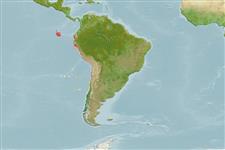Actinopterygii (ray-finned fishes) >
Perciformes (Perch-likes) >
Serranidae (Sea basses: groupers and fairy basslets) > Incertae sedis
Etymology: Hemilutjanus: Greek, hemi = the half + see under Lutjanus.
Issue
Family placement uncertain; see also the genus account: incertae sedis in Percoidei, Johnson, 1984.
Environment / Climate / Range
Ecology
Marine; pelagic-neritic; depth range 10 - 55 m (Ref. 104864). Tropical, preferred ?; 2°N - 54°S, 92°W - 70°W
Southeast Pacific: Peru to Chile and the Galapagos Islands.
Size / Weight / Age
Maturity: Lm ? range ? - ? cm
Max length : 50.0 cm SL male/unsexed; (Ref. 28023); max. published weight: 1.7 kg (Ref. 53696)
Dorsal
spines
(total): 10;
Dorsal
soft rays
(total): 10-11;
Anal
spines: 3. Deep, compressed body, brown, somewhat lighter on the lower half; a dark streak along the lateral line. Large mouth, compressed head. Serrated preopercular margin. Lateral line complete. Small scales. Caudal fin emarginate (Ref. 28023).
Found near drop-offs and among rock out-croppings over sand and rock, in depths greater than 10 meters. Feeds on small fishes and crustaceans (Ref. 28023).
Life cycle and mating behavior
Maturity | Reproduction | Spawning | Eggs | Fecundity | Larvae
Grove, J.S. and R.J. Lavenberg, 1997. The fishes of the Galápagos Islands. Stanford University Press, Stanford, 863 p. (Ref. 28023)
IUCN Red List Status (Ref. 115185)
CITES (Ref. 94142)
Not Evaluated
Threat to humans
Harmless
Human uses
Fisheries: subsistence fisheries
More information
Common namesSynonymsMetabolismPredatorsEcotoxicologyReproductionMaturitySpawningFecundityEggsEgg development
ReferencesAquacultureAquaculture profileStrainsGeneticsAllele frequenciesHeritabilityDiseasesProcessingMass conversion
Tools
Special reports
Download XML
Internet sources
